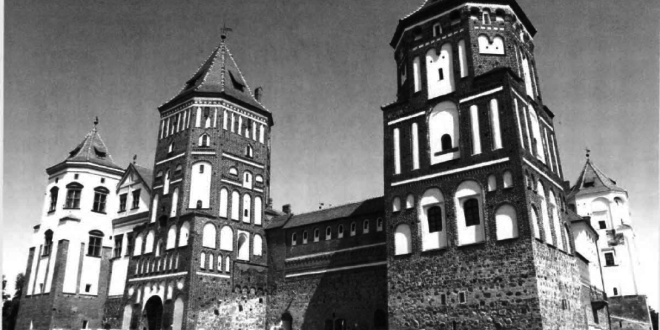On each of our trips to Vilnius, my husband Paul and I make it a point to leave Old Town, where we always base ourselves and spend most of our time, to stroll along Gediminas Prospect in New Town. It’s a one-mile walk along a route lined with cafes and shops, made longer by our many stops to eat and shop. Our goal, however, is Lithuania’s Parliament at the end of Gediminas Prospect. For us it’s a pilgrimage to honor those who died, were shot or crushed beneath Soviet tanks at the TV Tower in January 1991, almost a year after Lithuania declared its independence from the USSR.
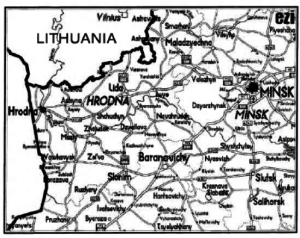
On one side of the modern Parliament building are the remnants of the 1991 barricades, now enclosed in glass to protect them. But on the opposite side, we noticed something new on our last trip in July 2013. A timeline of Lithuania’s history has been erected there, graphically displaying the extent of Lithuania’s territory at various points in its thousand years of documented history.
What most riveted our attention was the display labeled “1392 to 1430.” It showed Lithuania, then called the Grand Duchy of Lithuania, sprawled across much of Eastern Europe, encompassing present-day Lithuania as well as parts of Poland, Russia, Ukraine, Moldova, Latvia and all of Belarus. The Grand Duchy was the largest state in Europe at the time.
The fact that the Grand Duchy included Belarus interested us the most, since we had planned a three-day excursion there as part of our next trip to Lithuania. We decided to search for Lithuania’s medieval and Renaissance past while in Belarus, visiting castles associated with Lithuania’s grand dukes, the Lithuanian nobility, or both.
It’s a drive of 105 miles from Vilnius to historic Grodno in western Belarus. The roads are good, but delays at the Lithuanian-Belarusian border can stretch into hours. We were not lucky; our Belarusian driver told us the Lithuanians were “miffed” at the Belarusians—or vice-versa—so our border crossing took almost three hours.
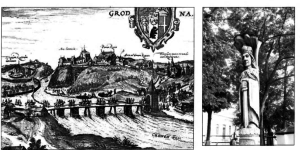
Grodno / Hrodna / Gardinas
Grodno, which the Belarusians call Hrodna, and the Lithuanians Gardinas, is located on the Neman (Nemunas) River, just eighteen miles from today’s Lithuanian border. Grodno began as a fortified trading center, possibly as early as the late tenth century. By the middle of the thirteenth century, it had come under the control of Lithuanians, notably Mindaugas (c. 1200-1263), Lithuania’s first and only crowned king, who is credited with founding the Lithuanian state. Vytautas, grand duke at the time of Lithuania’s greatest territorial extent in the early fifteenth century, stayed here while preparing for the Battle of Žalgiris/ Griinwald (1410), which successfully and decisively eliminated the threat to Lithuanian territories from the Teutonic Knights.
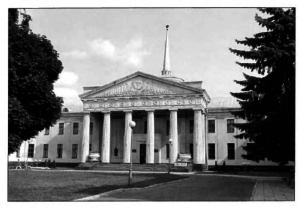
Stephen Bathory, Grand Duke of Lithuania as well as King of Poland (and Prince of Transylvania to boot), made Grodno his royal residence in the late sixteenth century. A later grand duke and king, Stanislaw II August, abdicated here in 1795 after the Third Partition of the Polish-Lithuanian Commonwealth, when Russia swallowed up Lithuania. He was the last king and grand duke of the Commonwealth.
What’s left at Grodno are two castles high above the river, linked by an arched stone bridge. The one called Old Grodno Castle was built by Grand Duke Vytautas around 1390-1400. It was rebuilt in Renaissance style by Stephen Bathory almost two hundred years later. The castle’s five Gothic towers are gone, but a good stretch of stone wall, a nowdry moat and a two-story Prince’s Palace are left. The Old Castle suffered greatly during the Russo-Polish War of 1654-1667 (also called the Thirteen Years’ War) and the Great Northern War with Sweden in 1700-1721.
After a major fire in 1735, the New Grodno Castle was built just steps away from the Old Castle and joined to it by a stone bridge. This new castle was home to two rulers, August III (1696-1763), who made it his summer residence, and Stanislaw II August (1732-1798), who abdicated here. Because of the devastation of World War Two, little is left of the original eighteenth century palace, but it’s since been reconstructed as a grand neoclassical structure.
Both castles now serve as museums. The Old Castle houses a small archaeology and folk art collection plus very large natural history and history museums. The New Castle disp lays period furnished rooms and art. We were told by a castle administrator of plans to restore the Old Grodno Castle to look the way it did during the Renaissance reign of Stephen Bathory.
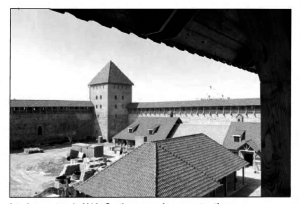
Throughout most of the life of the Grand Duchy, Grodno was its second largest and most important city after Vilnius. Grand dukes often resided here, important foreign visitors were received here, and this is where the Seimas (Parliament of the Polish-Lithuanian Commonwealth) often convened.
Lida / Lyda
Our next stop was Lida Castle (Lyda or Lydos pilis in Lithuanian), seventy-one miles northeast of Grodno. Lida was one of several castles built in the early fourteenth century by Grand Duke Gediminas, who is also credited with founding the city of Vilnius. He built the castles to defend against the Teutonic Knights, who warred against the Lithuanians in a “crusade,” ostensibly to convert the pagan Lithuanians to Christianity, but actually to acquire territory for themselves.
An interesting aside: in the fifteenth century, Grand Duke Vytautas gave Lida Castle to Khan Tokhtamysh, his military ally, who was a descendent of Genghis Khan’s eldest grandson. Tokhtamysh had revolted against Timur (or Tamerlane), one of the greatest of the Mongolian conquerors, and needed a safe refuge.
From the outside, the brick-faced castle is imposing and seemingly impregnable, with two tall towers at its northwest and southeast corners. Yet the Teutonic Knights managed to capture it several times during the fourteenth century, as did the Crimean Tatars in 1506; the Russians in 1659, during the Russo-Polish War; and the Swedes in the early eighteenth century, during the Great Northern War, when they blew up the castle’s towers.
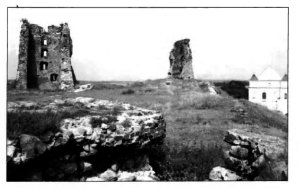
An entire settlement with barracks, stables and wells once stood inside the large, 264 foot square, courtyard, which is now being restored and will soon house a restaurant and gift shops in the reconstructed buildings. In the meantime, visitors can walk along the wooden walkways high along the castle’s inner wall and climb inside one of its towers.
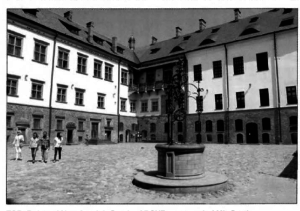
Navahrudak / Naugardukas
It’s only a twenty-seven mile drive southeast of Lida to Navahrudak, which Lithuanians call Naugardukas. It’s hard to imagine this castle’s historic importance from what’s left. On one of the highest hills in Belarus (1,066 feet), high above the city of Navahrudak, stand two ruined towers, all that remains of one of the most important strongholds of the Grand Duchy of Lithuania and once the center of its growing empire.
Lithuanian King Mindaugas may have been crowned here in 1253 and possibly buried here or nearby in 1263. After repeated attacks by the Teutonic Knights throughout the fourteenth century (1314, 1321, 1341,1390,1394), Grand Duke Vytautas added four stone towers to the castle. Three more were built a century later to strengthen its defenses, but this didn’t stop the sieges of the Crimean Tatars (1505), Russians (1654-1657) and Swedes (1706), not to mention the devastation of twentieth century wars and occupations. The two towers are the sole survivors of750 years of turbulent history.
Mir / Myras / Myrius
Thirty-two miles southeast of the sad, scanty ruins of Navahrudak stands the glorious palace of Mir (Lithuanians call it Myras or My rius). The land that Mir Castle stands on once belonged to Grand Duke Vytautas, who gave it to his brother Žygimantas Kęstutaitis, who himself became grand duke in 1432. In the early sixteenth century, Mir passed to Yuri Ilyinich, a local magnate, who built the first castle here, a fortress like structure of thick walls, towers, drawbridge and moat. Since his grandson died childless, in 1568- 1569 the castle passed into the hands of the famous and prolific Radvila- Radziwitt family.
The Radvilas, a family of Lithuanian origin, rose to prominence and power in the fourteenth century, acquiring land and properties in Lithuania, Poland, Ukraine and Belarus. When they acquired Mir by inheritance, they transformed it from a fortress into a splendid Renaissance palace with an Italian-style garden and an artificial lake. This was to be their family home for almost 250 years, through the Russo-Polish War of the mid-seventeenth century, the Great Northern War of the early eighteenth century, the Kosciuška (Kosciuszko) Uprising of 1794 and the Franco-Russian War of the early nineteenth century, until finally abandoned in 1813.
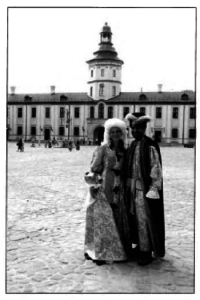
the Czech Republic, he’s from
Kuwait)
In 1891, the ruined property was sold to the Svyatopolk-Mirsky family, which owned many of the businesses in the town of Mir. They owned Mir Palace until 1939. Restoration began in 1982, and it was added to the prestigious UNESCO World Heritage List in 2000.
Mir is a magnificent palace with five towers overlooking a small quadrangular courtyard; one tower serves as the entry to the palace. The faęade is a blend of red brick interspersed with white sandstone, a colorful and beautiful mix. The palace rooms are furnished to represent different periods in the castle’s history: medieval armor, a Gothic-era kitchen, mannequins in sixteenth century dress, Renaissance tapestries and coffered ceilings, and a nineteenth century study. They all blend well to give an idea of how the Radvilas, their predecessors and their successors lived.
Nesvizh / Nesvyžius
Twenty-one miles southeast of Mir lies another Radvila palace, Nesvizh (Lithuanians call it Nesvyžius), that first belonged to Lithuanian grand dukes. A town called Nesvizh is documented in 1223, but it was only in the sixteenth century that it passed to the Radvilas. In 1582, Mikalojus Kristupas Radvila began to build a Renaissance-style palace on top of the preexisting medieval castle. When this palace was damaged in 1706, during the Great Northern War, the family rebuilt it in Baroque style, creating a grand complex of several buildings surrounding a large inner courtyard. An English-style park was added in the 1880s.
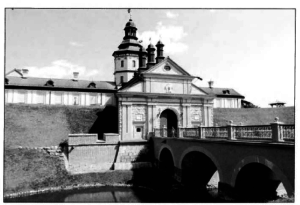
Entry into Nesvizh is made across a stone bridge, over a moat and through an impressive neoclassical gatehouse. From the courtyard with its well, visitors can explore stately rooms full of crystal chandeliers, wood-paneled rooms with walls hung with portraits of generations of Radvilas, heavy Renaissance wooden furniture and the wonderful tall tiled stoves used to warm rooms in wintertime. One room houses a collection of dolls dressed richly in period costume to give visitors an idea of what one wore while living in these elegant spaces.
A short walk from the palace, the Corpus Christi Church houses the coffins of seventy-two Radvilas. Built in the late sixteenth century, this church is considered one of the earliest, if not the earliest, Baroque buildings in Eastern Europe. Nesvizh was added to the UNESCO World Heritage List in 2005.
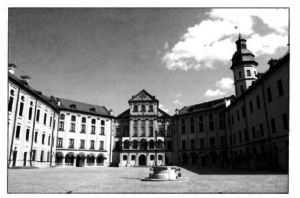
Before visiting our seventh and last castle in Belarus, we detoured sixtytwo miles to overnight in Minsk, the capital of Belarus. Sometimes described in guidebooks as grim, we found it anything but. As on a previous trip to Minsk six years ago, we enjoyed strolling the main boulevard, Nezavisimosti Avenue, lined with monumental Soviet-era buildings, with plenty of cafes along the way for snacks and people-watching. If you have the time, it’s worthwhile spending at least two or three nights in Minsk.
Krevo / Krewo / Kriavas
On our way back to Vilnius, we stopped at Krevo Castle (forty-two miles northwest of Minsk) located in a village just off the main MinskVilnius road. Lithuanians call it Kriavas. This, like Navahrudak Castle, is a sad ruin of crumbling towers and walls; although there’s much more left than at Navahrudak.
Krevo was a fortified stone castle built in the early fourteenth century by Grand Duke Gediminas and occupied by him and his son Algirdas, one of Gediminas’s seven sons, three of whom became grand dukes. Kęstutis, one of the three, was imprisoned and probably murdered in this castle in 1382 by orders of his nephew, Jogaila. Grand Duke Vytautas was also imprisoned here by Jogaila, but escaped after he traded places with a maid servant and sneaked out of the castle wearing her clothes.
Krevo Castle is best known as the place where the Union of Krevo or Krewo (Kriavo sutartis) was signed in 1385, establishing a dynastic union between the Grand Duchy of Lithuania and the Kingdom of Poland. In 1386, Jogaila was baptized in Krakow, married Queen Jadwiga of Poland and was crowned King of Poland as Wiadyslaw II Jagietto. He also retained his title of Grand Duke of Lithuania. Sacked by Crimean Tatars early in the sixteenth century, the castle slowly crumbled over the next four centuries until World War One put it on the front between Russian and German forces, reducing it to the ruins you see today.
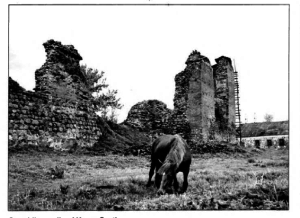
It was here in Krevo, standing in a vast trapezoidal space now overgrown with waist-high grass and surrounded by dilapidated castle walls, that we ended our too-brief three-day foray into Lithuania’s days of glory. A lone horse standing outside a broken-down barn beside the ruins followed our movements with curiosity as we stumbled over grass-covered hillocks inside Krevo Castle’s courtyard trying to imagine how it once looked.
 DRAUGAS NEWS Lithuanian World Wide News in English
DRAUGAS NEWS Lithuanian World Wide News in English
